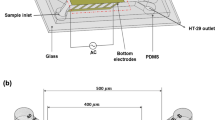Abstract
The manipulation and detection of rare cells are important for many applications in early disease diagnosis and medicine. This study presents a dielectrophoresis (DEP) microfluidic enrichment platform combined with a built-in capacitive sensor for circulating tumor cell detection. The microchip is composed of a lollipop-shaped gold microelectrode structure under a polydimethylsiloxane chamber. A prototype of the device was fabricated using standard micromachining technology. With the proposed device, target cells (in this study, A549 non-small human lung carcinoma and S-180 sarcoma cell lines) are firstly guided toward the center of the working chamber via DEP forces. Then, the target cells are captured by an electrode immobilized by anti-EGFR, which has high affinity toward the target cells. After the cell concentration process, the differential capacitance is read to detect the presence of the target cells. Numerical simulations and measurement experiments were performed to demonstrate the high sensitivity of differential capacitive sensing. The obtained results show high sensitivity for S-180 cell detection (3 mV/cell). The proposed platform is suitable for rapid cancer diagnoses and other metabolic disease applications.
Similar content being viewed by others
References
Chen, Y.C. et al. Rare cell isolation and analysis in microfluidics. Lab Chip 14, 626–645 (2014).
Pantel, K., Brakenhoff, R.H. & Brandt, B. Detection, clinical relevance and specific biological properties of disseminating tumour cells. Nat. Rev. Cancer 8, 329–340 (2008).
Mostert, B., Sleijfer, S., Foekens, J.A. & Gratama, J.W. Circulating tumor cells (CTCs): Detection methods and their clinical relevance in breast cancer. Cancer Treat. Rev. 35, 463–474 (2009).
Vona, G. et al. Isolation by Size of Epithelial Tumor Cells. Am. J. Pathol. 156, 57–63 (2000).
Cho, S.H. et al. Human mammalian cell sorting using a highly integrated micro-fabricated fluorescence-activated cell sorter (µFACS). Lab Chip 10, 1567–1573 (2010).
Jacob, K., Sollier, C. & Jabado, N. Circulating tumor cells: detection, molecular profiling and future prospects. Expert Rev Proteomics 4, 741–756 (2007).
Hatanaka, H., Yasukawa, T. & Mizutani, F. Detection of surface antigens on living cells through incorporation of immunorecognition into the distinct positioning of cells with positive and negative dielectrophoresis. Anal. Chem. 83, 7207–7212 (2011).
Jen, C.P. & Chen, T.W. Selective trapping of live and dead mammalian cells using insulator-based dielectrophoresis within open-top microstructures. Biomed. Microdevices 11, 597–607 (2009).
Te Huang, C. et al. Selectively concentrating cervical carcinoma cells from red blood cells utilizing dielectrophoresis with circular ITO electrodes in stepping electric fields. J. Med. Biol. Eng. 33, 51–58 (2013).
Voldman, J. Electrical Forces for Microscale Cell Manipulation. Annu. Rev. Biomed. Eng. 8, 425–454 (2006).
Ramos, A., Morgan, H., Green, N.G. & Castellanos, A. Ac electrokinetics: a review of forces in microelectrode structures. J. Phys. D. Appl. Phys. 31, 2338–2353 (1999).
Jen, C.P., Chang, H.H., Te Huang, C. & Chen, K.H. A microfabricated module for isolating cervical carcinoma cells from peripheral blood utilizing dielectrophoresis in stepping electric fields. Microsyst. Technol. 18, 1887–1896 (2012).
Hassan, A.M. & El-Shenawee, M. Review of electromagnetic techniques for breast cancer detection. IEEE Rev. Biomed. Eng. 4, 103–118 (2011).
Coltro, W.K.T. et al. Capacitively coupled contactless conductivity detection on microfluidic systems -ten years of development. Anal. Methods 4, 25–33 (2012).
Wu, J., Ben, Y. & Chang, H.C. Particle detection by electrical impedance spectroscopy with asymmetric-polarization AC electroosmotic trapping. Microfluid. Nanofluidics 1, 161–167 (2005).
Suehiro, J., Yatsunami, R., Hamada, R. & Hara, M. Quantitative estimation of biological cell concentration suspended in aqueous medium by using dielectrophoretic impedance measurement method. J. Phys. D. Appl. Phys. 32, 2814–2820 (1999).
Huck, C. et al. Capacitively coupled electrolyte-conductivity sensor based on high-k material of barium strontium titanate. Sensors Actuators, B Chem. 198, 102–109 (2014).
Vu Quoc, T., Nguyen Dac, H., Pham Quoc, T., Nguyen Dinh, D. & Chu Duc, T. A printed circuit board capacitive sensor for air bubble inside fluidic flow detection. Microsyst. Technol. 21, 911–918 (2015).
Valero, A., Braschler, T. & Renaud, P. A unified approach to dielectric single cell analysis: impedance and dielectrophoretic force spectroscopy. Lab Chip 10, 2216–2225 (2010).
Sun T. & Morgan, H. Single-cell microfluidic Impedance cytometry: A review. Microfluid. Nanofluidics 8, 423–443 (2010).
Nguyen Dac, H., Vu Quoc, T., Do Quang, L., Nguyen Hoang, H. & Chu Duc, T. Differential C4D sensor for conductive and non-conductive fluidic channel. Microsyst. Technol. 22, 2511–2520 (2016).
Hassan, U., Watkins, N.N., Reddy, B., Damhorst, G. & Bashir, R. Microfluidic differential immunocapture biochip for specific leukocyte counting. Nat. Protoc. 11, 714–726 (2016).
Chen, G.H. et al. Isolating and concentrating rare cancerous cells in large sample volumes of blood by using dielectrophoresis and stepping electric fields. BioChip J. 8, 67–74 (2014).
Elmy Johana, M.D. et al. Sensor Modeling For Portable Electrical Capacitance Tomography System Using Simulation by COMSOL Multiphysics. Int. J. Innov. Comput. Inf. Control. 8, 6999–7016 (2012).
Opekar, F., Tuma, P. & Štulík, K. Contactless impedance sensors and their application to flow measurements. Sensors (Switzerland) 13, 2786–2801 (2013).
Tong, X., Yang, L., Lang, J.C., Zborowski, M. & Chalmers, J.J. Application of immunomagnetic cell enrichment in combination with RT-PCR for the detection of rare circulating head and neck tumor cells in human peripheral blood. Cytometry. B Clin. Cytom. 72, 310–323 (2007).
Author information
Authors and Affiliations
Corresponding authors
Rights and permissions
About this article
Cite this article
Do, L.Q., Thuy, H.T.T., Bui, T.T. et al. Dielectrophoresis Microfluidic Enrichment Platform with Built-In Capacitive Sensor for Rare Tumor Cell Detection. BioChip J 12, 114–122 (2018). https://doi.org/10.1007/s13206-017-2204-x
Received:
Accepted:
Published:
Issue Date:
DOI: https://doi.org/10.1007/s13206-017-2204-x




